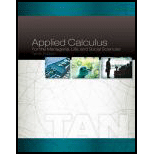
a.
To fill: The blank in the statement “The nth Taylor polynomial of f at a is the polynomial
a.
Answer to Problem 1CRQ
The nth Taylor polynomial of f at a is the polynomial
Explanation of Solution
Let f be a function and its first n derivatives are defined at a.
Then the nth Taylor polynomial of f at a is the polynomial,
Therefore, the nth Taylor polynomial of f at a is the polynomial
b.
To fill: The blank in the statement “In terms of f and its derivatives, we have
b.
Answer to Problem 1CRQ
In terms of f and its derivatives, we have
Explanation of Solution
Let f be a function and its first n derivatives are defined at a.
Then the nth Taylor polynomial of f at a is the polynomial,
So it coincides with
Therefore, in terms of f and its derivatives, we have
Want to see more full solutions like this?
Chapter 11 Solutions
Applied Calculus for the Managerial, Life, and Social Sciences (MindTap Course List)
- Let f(x)= √(1+(x/5)). (a) Find the Taylor polynomial of f(x) of order 2 about the origin. Hint: For this part there is no need to include the remainder.arrow_forwardExample:- Find the Taylor polynomials Pn(x) generated by f(x) = ex at x = 0 Solution:- The given function and its derivative are. f(x) = ex, f'(x) = ex,...., f(n)(x) = exarrow_forward
- Algebra & Trigonometry with Analytic GeometryAlgebraISBN:9781133382119Author:SwokowskiPublisher:Cengage
 Linear Algebra: A Modern IntroductionAlgebraISBN:9781285463247Author:David PoolePublisher:Cengage Learning
Linear Algebra: A Modern IntroductionAlgebraISBN:9781285463247Author:David PoolePublisher:Cengage Learning

